Publication
Article
Pharmacy Times
Arthritis Watch
Sponsored by

New Fibromyalgia Diagnostic Criteria Proposed
Fibromyalgia, characterized by longterm, body-wide pain and tender points in soft tissues, may now be diagnosed with a new set of criteria that include common symptoms such as fatigue, sleep disturbances, and cognitive problems, in addition to pain. The American College of Rheumatology (ACR) has proposed these new criteria, which were published in the May issue of the ACR journal Arthritis Care & Research.
Fibromyalgia has been diagnosed by a tender point test—a physical test that focuses on 18 points throughout the body. Patients with the condition feel tenderness or pain when light pressure is applied to points around the neck, shoulder, chest, hip, knee, and elbow regions. This test, however, did not “take into account the importance of common symptoms including significant fatigue, a lack of mental clarity and forgetfulness, sleep problems, and an impaired ability to function doing normal activities,” according to one of the authors, Robert S. Katz, MD, rheumatologist at Rush University Medical Center.
The flawed tender point test will be replaced with a widespread pain index and a symptom severity scale. To determine the widespread pain index score, the number of areas on the body (19 specific possible areas) where the patient has felt pain in the past week will be counted. The latter scale rates the severity of 3 common symptoms—fatigue, waking unrefreshed, and cognitive symptoms— on a scale of 0 to 3, where 3 is the most pervasive. Some diagnostic criteria will remain the same.
OA Linked to Uneven Leg Length
A common physical trait—having one leg longer than the other—may be linked with the painful and debilitating condition of arthritis in the knee. A direct link between leg unevenness and osteoarthritis (OA) is not clear, but the results of a recent study published in the March 2, 2010, issue of Annals of Internal Medicine may allow individuals to take preventive measures.
William F. Harvey, MD, MSc, lead researcher from Boston University School of Medicine and Tufts Medical Center, Boston, Massachusetts, and colleagues examined full-limb x-ray images of 3026 participants aged 50 to 79 years with or at high risk for knee OA, as a part of the international Multi Centre Osteoarthritis Study. The researchers found, in patients with leg-length inequality of 1 cm or more, prevalent radiographic and symptomatic OA in the shorter leg, incident symptomatic OA in the shorter leg and the longer leg, and increased odds of progressive OA in the shorter leg. Derek Cooke, MA, MB, BChir, one of the coauthors of the study and adjunct professor at Queen’s University, in Kingston, Ontario, Canada, suggested that early detection may help deter OA: “If we can spot factors creating changes in alignment early in bone development, theoretically we could stop or slow down the progression of [OA].”
RA in Women on the Rise
Between 1995 and 2007, the incidence of rheumatoid arthritis (RA) in women has slowly risen, according to the results of a study published in the June issue of Arthritis & Rheumatism. Researchers hypothesize that this increased incidence, which followed a 40-year period of decline, could be due to environmental factors such as cigarette smoking, vitamin D deficiency, and lower-dose oral contraceptives.
Lead author Sherine Gabriel, MD, MSc, and colleagues from the Mayo Clinic looked at medical records of 1761 Olmstead County, Minnesota, residents aged 18 years and older who had received one or more diagnoses of arthritis (excluding degenerative arthritis or osteoarthritis). After completing this review, the researchers made a diagnosis of RA in 466 patients (321 [69%] were women); mean age at RA incidence was 55.6 years. Among women, the results of the study showed a 2.5% increase per year over the period 1995-2007; a decrease of 0.5% was noted for men, however.
Dr. Gabriel and her team attributed this increase in RA in women to various environmental factors such as cigarette smoking (which is associated with a greater risk for RA development; rates have decreased overall, but to a slower extent in women compared with men); lower doses of estrogens in today’s oral contraceptives (which offer less protection than higher doses in older medications); and vitamin D deficiency. Dr. Gabriel concluded, “Reasons for the increase in incidence we found are unknown, but environmental factors likely play a role and should be further explored.”
ON THE WEB: For pharmacist-recommended products for arthritis, go to www.OTCGuide.net. Click on: Pain/Inflammation.
Pharmacy Times is responsible for the content on this page.







